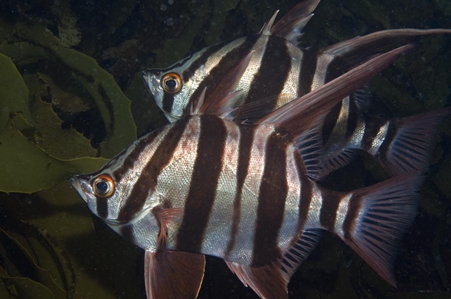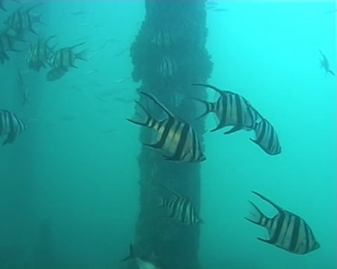General Description
Body deep, very compressed; head concave, snout short, pointed; dorsal and anal fins high anteriorly, first dorsal distinctly separate from the second; pelvic fins large, prominent. Body silvery-white to cream, with 6-8 dark brown to black vertical bands of varying widths, the widest and most prominent bands extending from spinous dorsal-fin to pelvic fin, and from tip of second dorsal fin through beginning of soft anal-fin rays respectively. Pale part of fins may be pinkish. To 30 cm.
Biology
The name "Old Wife" comes from the grinding or grating noise made by the fish when captured. These fishes are widespread and common throughout their range, and found in pairs, or more commonly in large schools. Old wives sometimes set up cleaning stations to remove parasites from other fishes. They are the only species in the Family Enoplosidae.
Habitat
On rocky reefs, and around jetties and pier piles in bays, harbours and in sheltered areas along the coast; juveniles often shelter in seagrass beds, in depths of 0-85 m.
Reefs
Seagrass meadows
Distribution guide
Southern Australia.
Species Group
Depth
Shore (0-1 m)
Shallow (1-30 m)
Deep ( > 30 m)
Water Column
Max Size
30 cm
Diet
Carnivore
Harmful
Venomous fin spines and can inflict a painful sting.
Commercial Species
No
Global Dispersal
Native to Australia
Conservation Status
- DSE Advisory List : Not listed
- EPBC Act 1999 : Not listed
- IUCN Red List : Not listed









